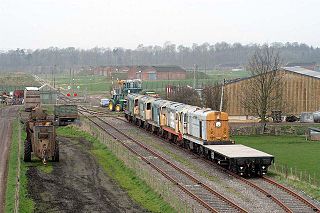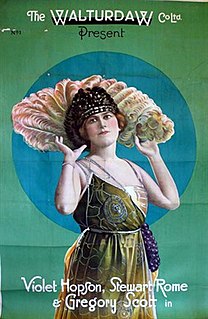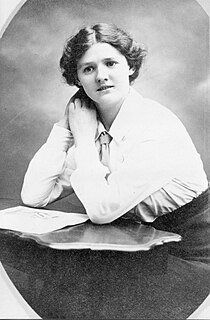Related Research Articles

Alice Adams is a 1921 novel by Booth Tarkington that received the 1922 Pulitzer Prize for the Novel. It was adapted as a film in 1923 by Rowland V. Lee and more famously in 1935 by George Stevens. The narrative centers on the character of a young woman who aspires to climb the social ladder and win the affections of a wealthy young man named Arthur Russell. The story is set in a lower-middle-class household in an unnamed town in the Midwest shortly after World War I.

H.M. Factory, Gretna was the United Kingdom's largest cordite factory in World War I. The government-owned facility was adjacent to the Solway Firth, near Gretna, Dumfries and Galloway. It was built by the Ministry of Munitions in response to the Shell Crisis of 1915. The capital cost was £9,184,000 and it covered 9000 acres. The cost of working it from September 1916 to September 1918 was £12,769,000, during which time it produced cordite valued at £15,000,000, though it was claimed that without it the cordite would have had to be imported from the USA at a cost of £23,600,000.

Munitionettes were British women employed in munitions factories during the time of the First World War.
The Ware Case is a 1917 British silent drama film directed by Walter West and starring Matheson Lang, Violet Hopson and Ivy Close. It is an adaptation of the play The Ware Case by George Pleydell Bancroft, filmed again in 1928 and in 1938.

The Case of Lady Camber is a 1920 British silent mystery film directed by Walter West and starring Violet Hopson, Stewart Rome and Gregory Scott. Lord Camber comes under suspicion of murdering his wife, an ex-chorus girl. It was adapted from a 1915 play of the same title by Horace Annesley Vachell. It was made at Walthamstow Studios.
The Man Who Stayed at Home is a 1915 British silent thriller film directed by Cecil M. Hepworth and starring Dennis Eadie, Violet Hopson and Alma Taylor. It is based on the play by Lechmere Worrall and J. E. Harold Terry.
Sweet Lavender is a 1915 British silent romance film directed by Cecil M. Hepworth and starring Henry Ainley, Chrissie White and Alma Taylor. It is based on the 1888 play Sweet Lavender by Arthur Wing Pinero.
The Romance of a Movie Star is a 1920 British silent romance film directed by Richard Garrick and starring Violet Hopson, Stewart Rome and Gregory Scott. It is based on the novel The World's Best Girl by Coralie Stanton.
The Heart of Midlothian is a 1914 British silent historical film directed by Frank Wilson and starring Flora Morris, Violet Hopson and Alma Taylor. It is an adaptation of Sir Walter Scott's 1818 novel The Heart of Midlothian.
The Nightbirds of London is a 1915 British silent crime film directed by Frank Wilson and starring Stewart Rome, Chrissie White and Violet Hopson. It was based on a play by George R. Sims.
The House of Fortescue is a 1916 British silent drama film directed by Frank Wilson and starring Stewart Rome, Violet Hopson and Lionelle Howard. An Australian millionaire marries a woman to help save her father's business from ruin.
The Snare is a 1918 British silent romance film directed by Frank Wilson and starring Violet Hopson, George Foley and Trevor Bland. The screenplay concerns a woman marries a millionaire who likes to go poaching.
The Eternal Triangle is a 1917 British silent romance film directed by Frank Wilson and starring Chrissie White, Stewart Rome and Violet Hopson. A woman loves a poor squire's son but marries a much wealthier playwright who is subsequently killed in a car accident.
The White Hope is a 1915 British silent sports film directed by Frank Wilson and starring Stewart Rome, Violet Hopson and Lionelle Howard. It is set in the world of boxing.
Sisters in Arms is a 1918 British silent short film directed by Walter West and starring Violet Hopson, Hazel Jones and Hilda Bayley. It was made to boost female recruitment into the Armed Forces during the First World War.
The Gentleman Rider is a 1919 British silent sports drama film directed by Walter West and starring Violet Hopson, Stewart Rome and Gregory Scott.
A Call For Arms is a short propaganda film made for the British Ministry of Information in 1940. It was directed by Brian Desmond Hurst and starred Jean Gillie and Rene Ray as two 'nudes' (showgirls) who do their bit for the war effort by going to work in munition factories. It was co-written by a Sgt. Terence Young who worked for Hurst on many projects before, during and after World War II.
This is a list of people appointed Member of the Order of the British Empire (MBE) in the 1918 New Year Honours.

Maud Ellen Bruce was a forewoman and a member of the fire brigade at H.M. Factory Gretna during World War I. She was also the recipient of an O.B.E. for her actions at the factory. In World War Two she worked at ROF Aycliffe, where during an accident with some ammunition, she was severely burnt. She lived to be 100 years old and was one of the first women in Britain to receive plastic surgery.

The Gretna Girls was a collective nickname given to women munition workers at HM Factory Gretna in World War One. Women came from all over the United Kingdom to work at the factory, but many were drawn from the surrounding areas of Scotland and Northern England.
References
- ↑ Palmer p.368